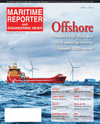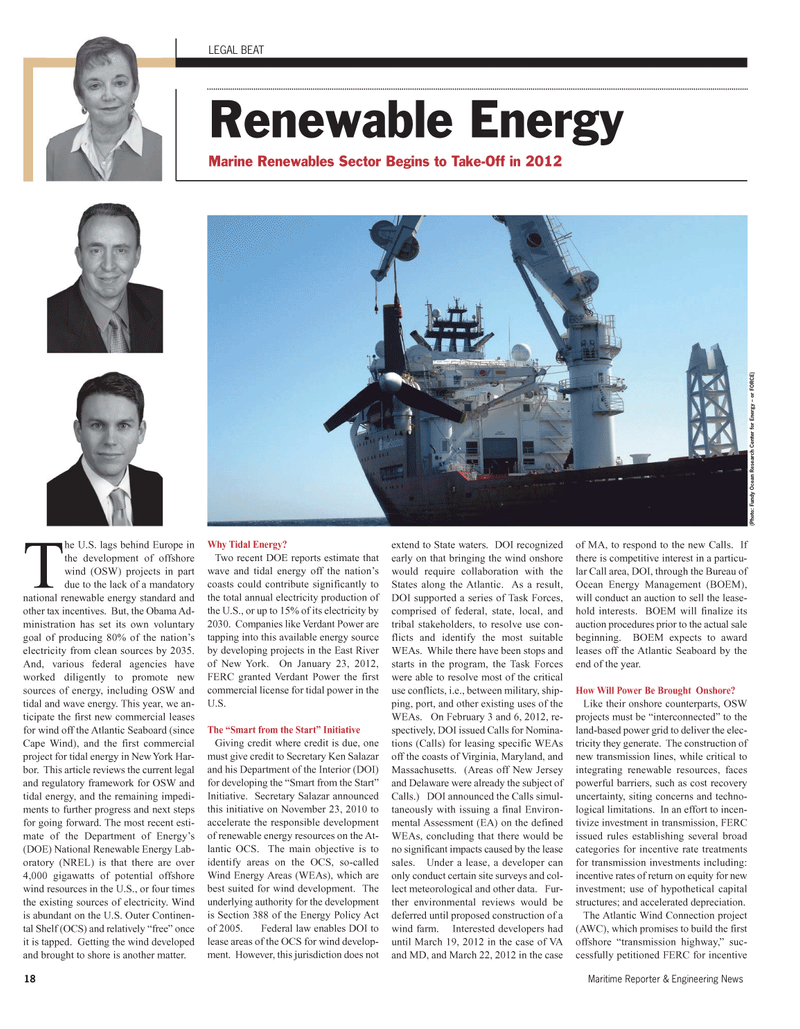
Page 18: of Maritime Reporter Magazine (April 2012)
Offshore Deepwater Annual
Read this page in Pdf, Flash or Html5 edition of April 2012 Maritime Reporter Magazine
18Maritime Reporter & Engineering News The U.S. lags behind Europe inthe development of offshore wind (OSW) projects in partdue to the lack of a mandatorynational renewable energy standard and other tax incentives. But, the Obama Ad- ministration has set its own voluntary goal of producing 80% of the nations electricity from clean sources by 2035.And, various federal agencies have worked diligently to promote new sources of energy, including OSW and tidal and wave energy. This year, we an- ticipate the first new commercial leases for wind off the Atlantic Seaboard (since Cape Wind), and the first commercial project for tidal energy in New York Har- bor. This article reviews the current legal and regulatory framework for OSW and tidal energy, and the remaining impedi- ments to further progress and next steps for going forward. The most recent esti- mate of the Department of Energys (DOE) National Renewable Energy Lab- oratory (NREL) is that there are over 4,000 gigawatts of potential offshore wind resources in the U.S., or four timesthe existing sources of electricity. Wind is abundant on the U.S. Outer Continen- tal Shelf (OCS) and relatively free? once it is tapped. Getting the wind developed and brought to shore is another matter. Why Tidal Energy? Two recent DOE reports estimate that wave and tidal energy off the nations coasts could contribute significantly to the total annual electricity production ofthe U.S., or up to 15% of its electricity by2030. Companies like Verdant Power are tapping into this available energy source by developing projects in the East River of New York. On January 23, 2012, FERC granted Verdant Power the first commercial license for tidal power in the U.S. The Smart from the Start? Initiative Giving credit where credit is due, one must give credit to Secretary Ken Salazar and his Department of the Interior (DOI)for developing the Smart from the Start? Initiative. Secretary Salazar announced this initiative on November 23, 2010 to accelerate the responsible development of renewable energy resources on the At- lantic OCS. The main objective is to identify areas on the OCS, so-calledWind Energy Areas (WEAs), which are best suited for wind development. The underlying authority for the development is Section 388 of the Energy Policy Act of 2005. Federal law enables DOI to lease areas of the OCS for wind develop- ment. However, this jurisdiction does not extend to State waters. DOI recognized early on that bringing the wind onshorewould require collaboration with the States along the Atlantic. As a result, DOI supported a series of Task Forces, comprised of federal, state, local, andtribal stakeholders, to resolve use con- flicts and identify the most suitableWEAs. While there have been stops and starts in the program, the Task Forces were able to resolve most of the critical use conflicts, i.e., between military, ship- ping, port, and other existing uses of the WEAs. On February 3 and 6, 2012, re- spectively, DOI issued Calls for Nomina- tions (Calls) for leasing specific WEAs off the coasts of Virginia, Maryland, and Massachusetts. (Areas off New Jersey and Delaware were already the subject of Calls.) DOI announced the Calls simul- taneously with issuing a final Environ- mental Assessment (EA) on the defined WEAs, concluding that there would be no significant impacts caused by the lease sales. Under a lease, a developer can only conduct certain site surveys and col- lect meteorological and other data. Fur- ther environmental reviews would be deferred until proposed construction of awind farm. Interested developers had until March 19, 2012 in the case of VA and MD, and March 22, 2012 in the caseof MA, to respond to the new Calls. If there is competitive interest in a particu- lar Call area, DOI, through the Bureau ofOcean Energy Management (BOEM), will conduct an auction to sell the lease-hold interests. BOEM will finalize its auction procedures prior to the actual salebeginning. BOEM expects to award leases off the Atlantic Seaboard by the end of the year. How Will Power Be Brought Onshore? Like their onshore counterparts, OSW projects must be interconnected? to theland-based power grid to deliver the elec- tricity they generate. The construction of new transmission lines, while critical to integrating renewable resources, faces powerful barriers, such as cost recovery uncertainty, siting concerns and techno- logical limitations. In an effort to incen- tivize investment in transmission, FERC issued rules establishing several broad categories for incentive rate treatments for transmission investments including: incentive rates of return on equity for new investment; use of hypothetical capital structures; and accelerated depreciation.The Atlantic Wind Connection project (AWC), which promises to build the first offshore transmission highway,? suc- cessfully petitioned FERC for incentive LEGAL BEAT Renewable Energy Marine Renewables Sector Begins to Take-Off in 2012 (Photo: Fundy Ocean Research Center for Energy ? or FORCE)

 17
17

 19
19
